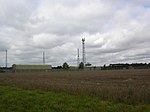Hobb's Mill
Grade II* listed buildings in NorfolkGrade II* listed windmillsNorth NorfolkSmock mills in EnglandWindmills of the Norfolk Broads ... and 1 more
Windpumps in the United Kingdom

Hobb's Mill, also known as Hobbs Drainage Mill, is an open trestle windpump which stands by the side of the River Bure in Horning, North Norfolk, England, and is a Grade II* listed structure.The mill was built before 1930, probably in the late 19th century. The frame is made of wood, with four braced cant posts standing on brick piers supporting a weatherboarded cap and fantail. In the picture, the four sails are missing. The mill was unique in that it was the only trestle mill to operate a scoop wheel. Both the mill and scoop wheel have been partly restored by the Windmill Trust.
Excerpt from the Wikipedia article Hobb's Mill (License: CC BY-SA 3.0, Authors, Images).Hobb's Mill
Ferry View Road, North Norfolk
Geographical coordinates (GPS) Address Nearby Places Show on map
Geographical coordinates (GPS)
| Latitude | Longitude |
|---|---|
| N 52.6932 ° | E 1.4724 ° |
Address
Ferry View Road
Ferry View Road
NR12 8PT North Norfolk
England, United Kingdom
Open on Google Maps










